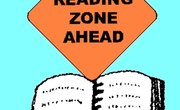Children are learning to read at an earlier age. Kindergartners are required to know the alphabet before arriving on the first day of school. Many classroom teachers spend the year integrating new reading programs to get children started. There are four popular methods for teaching first grade reading. The programs, geared toward reading levels, include the Guided Reading Level, Developmental Reading Assessment, Lexile Framework and Reading Recovery.
Guided Reading Level
Creators of the Fountas and Pinnell System, writers Irene C. Fountas and Gay Su Pinnell, designed the Guided Reading Level program to place children in a specific reading category through an alphabetic system.
In guided reading, the teachers work with a small group of children that are close in reading levels. First grade is A-I, which helps teachers pinpoint the exact level the student is reading. The large variety of books chosen for the program give the students a challenge as well as continue reiterating the words already familiar to their vocabulary. Children are also searching for meaning in the text they are reading.
Teachers talk with students about what they have learned from the reading.
Developmental Reading Assessment
This tool helps teachers assess where students are in their reading progress. The Developmental Reading Assessment, introduced by Joetta Beaver, is a scale that allows teachers to determine if students are reading accurately and with comprehension as well as gaining fluency in their reading.
Once teachers determine where the student is located on the numerical scale, they can better match them with books in the same level.
Lexile Frameworks
Also a numeric scale, the Scholastic Lexile Frameworks is a more precise measuring tool of student's reading levels. Designed by MetaMetrics, the program tests children on their reading level and matches them up with appropriate books. The research organization says, "A Lexile text measure is based on two strong predictors of how difficult a text is to comprehend: word frequency and sentence length."
As beginning readers, students in first grade would get a Lexile reader measure of around 200L, on the low end of the Lexile scale.
Over 100,000 books and millions of articles have received a Lexile score, making it easy for educators to match up with the reading level of children in schools.
Reading Recovery
Reading Recovery, a program designed by the Reading Recovery Council of North America, reaches out to first grade children slow to read and write. The one-on-one tutoring program is for children with the slowest learning strides in first grade.
A teacher specializing in reading recovery meets with the students on a daily basis, teaching concepts that help the child understand the basics of reading and writing comprehension until they have reached the desired level.
The program, developed in New Zealand over 30 years ago, has a 75 percent success rate. Reading Recovery started in the United States in 1984.
Related Articles
References
Writer Bio
Julie Pollitt started writing for publication in 1995. She gained experience as a reporter and editor at a Colorado newspaper. She has seen her work published in the Cortez Newspapers, "Four Corners Style" Magazine, "USA Today" and "Penned From the Heart." She is at work on her first contemporary Christian fiction novel.











